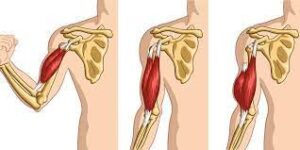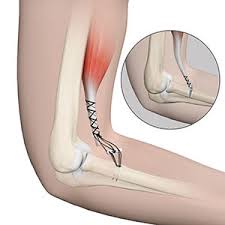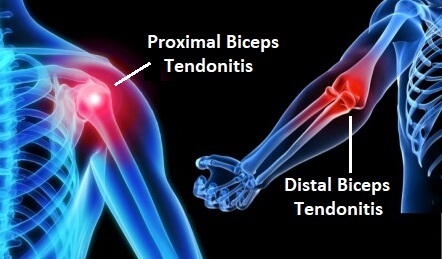If you are experiencing pain in your biceps, you may have a torn biceps tendon. This can be a very serious injury and requires immediate medical attention. In this blog post, we will discuss the causes, symptoms, and treatment of a torn biceps tendon.
Contents
What Is Torn Bicep Tendon?

A torn bicep tendon is a serious injury that can cause severe pain and disability. The biceps muscle is responsible for lifting the arm and rotating the forearm. The tendon attaches the muscle to the bone and allows for these movements. A tear can occur at either the shoulder end of the elbow end of the tendon.
What Are The Causes Of Torn Biceps Tendon?
A torn biceps tendon can occur due to a sudden injury or from repetitive stress over time. The most common cause of a torn biceps tendon is an injury that occurs while lifting something heavy. Other causes include:
A fall
landing on your outstretched arm or falling with your arm in an awkward position can put too much stress on the biceps tendon and cause it to tear. For example, you may fall while playing sports such as basketball, football, or tennis. Landing on your outstretched arm or falling with your arm in an awkward position can put too much stress on the biceps tendon and cause it to tear. For example, you may fall while playing sports such as basketball, football, or tennis.
Repetitive stress
overusing your arm in activities such as painting or weightlifting can put repeated stress on the biceps tendon and cause it to tear over time. For example, weightlifters who frequently curl heavyweights are at a higher risk of developing a torn biceps tendon.
Overuse
Repetitive motions that put a strain on the biceps tendon can lead to a gradual weakening of the tendon and eventually a tear. This is often seen in athletes who participate in sports that require overhead motions, such as baseball, tennis, and weightlifting.
Sudden injury
A direct blow to the arm can cause a sudden, acute injury to the biceps tendon. This is more common in contact sports, such as football and hockey. For example, a fall on an outstretched arm can put enough force on the biceps tendon to tear it away from the bone.
The biceps muscle is located in the front of the upper arm and helps to lift the arm. The biceps tendon attaches the biceps muscle to the shoulder bone. A torn biceps tendon can occur as a result of a sudden injury
With age, the tendons in the body can become weaker and more susceptible to injury. This is a common cause of biceps tendon tears in older adults. This is often due to a decrease in blood flow and collagen production.
Thus, these are the causes of a torn biceps tendon.
Symptoms

There are various symptoms of the torn biceps tendon. They are as follows:
1. Severe pain in the arm: This is one of the most common symptoms of a torn biceps tendon. The person experiences severe pain in the arm, which may worsen with movement.
2. Snapping or popping sound: Another symptom of a torn biceps tendon is hearing a snapping or popping sound when the injury occurs.
3. Bruising and swelling: There is usually bruising and swelling around the area of the injury.
4. Weakness in the arm: The person may also experience weakness in the affected arm, which may make it difficult to move the arm or lift objects.
5. Numbness or tingling: In some cases, the person may also experience numbness or tingling in the affected arm.
So these are the symptoms of a torn biceps tendon. If you experience any of these, then it is advisable to see a doctor as soon as possible.
Treatment Options
There are various treatment options which are included as follows:
Surgery
This is an option when the tendon is completely torn from the bone. The surgery involves reattaching the tendon to the bone using stitches or metal anchors. For instance, the surgeon will make an incision over the biceps muscle and insert metal anchors into the bone. After that, they will sew the tendon to the anchors. The surgery usually takes place under general anesthesia and takes about one to two hours. The arm will be placed in a sling for four to six weeks to allow for healing.
Physical therapy
This helps in restoring the range of motion as well as strengthening the muscles and tissues around the elbow. For example, your therapist may use massage, electrical stimulation, and stretching exercises to help you regain motion and function. It also helps in strengthening the muscles around the injured tendon.
Immobilization
This is done by wearing a sling or splint which helps in protecting the elbow and allowing it to heal. For instance, if the tendon is partially torn, immobilization for a few weeks might be recommended followed by physical therapy to help regain strength.
Pain medication
Pain medications may be necessary to help control your pain and allow you to perform therapy exercises. Anti-inflammatory medications, such as ibuprofen (Advil, Motrin IB) or naproxen (Aleve), can help reduce both the pain and inflammation associated with a torn biceps tendon.
Corticosteroid injections
In some cases, your doctor may recommend injecting a corticosteroid medication into the area around your biceps tendon to help reduce inflammation. For example, you may receive an injection of a corticosteroid and local anesthetic into the bicipital groove. Your doctor will use ultrasound guidance to ensure the needle is placed in the correct location.
Steroid injections are given to help reduce the inflammation around the torn tendon.
Surgery
This is considered a last resort when all other treatment options have failed to provide relief from pain. Surgery involves reattaching the tendon to the bone or removing the damaged portion of the tendon. Surgery may be required for a complete tear of the tendon. The surgeon will reattach the tendon to the bone or remove the damaged portion of the tendon.
Platelet-rich plasma injections (PRP)
This is a new treatment option that involves taking the patient’s blood and spinning it in a centrifuge to separate the platelets. These concentrated platelets are then injected into the area around the torn tendon to promote healing.
It is important to note that not all patients require surgery and that the decision to have surgery is made on a case-by-case basis.
Conclusion
It may be concluded that torn biceps tendon is a serious injury that can cause immense pain and discomfort. The best way to avoid this problem is by maintaining the good physical condition and avoiding any type of strenuous activity or exercise that may put undue stress on the biceps tendon. If you do experience any symptoms of a torn biceps tendon, it is important to seek medical attention immediately to prevent further damage to the tendon or surrounding tissues. With proper diagnosis and treatment, most people can make a full recovery from this injury and return to their normal level of activity.
Physical Therapy help patients recover from pain. If you’re experiencing Back pain, Shoulder pain, Knee pain, Neck pain, Elbow pain, Hip pain, or Arthritis pain, a physical therapist at MantraCare can help: Book a physiotherapy session.


